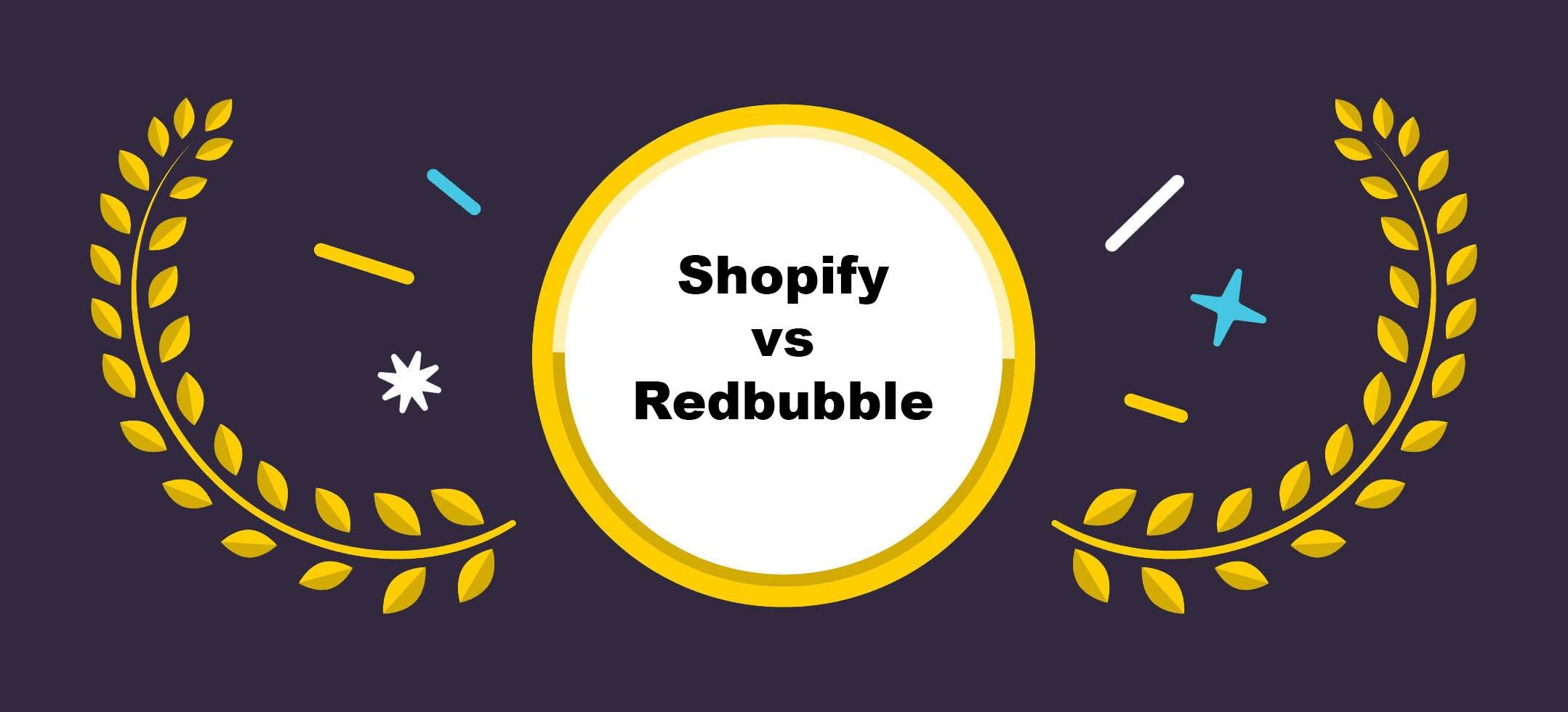Shopify and Redbubble are two of the most popular platforms for starting a print-on-demand (POD) business, but which one is a good fit for you?
After over a decade studying the ecommerce space and testing out dozens of POD setups, I’ve done a deep dive comparison of Shopify and Redbubble to see how they stack up in key areas such as pricing, features, profit potential, marketing tools, and more.
My honest opinion?
Shopify is the clear choice if you’re serious about building a real brand and business.
But Redbubble still has its place – especially for total beginners or people just dipping their toes in POD
Let’s get down to business.
Shopify vs Redbubble: An Initial Verdict
| Best For | Platform |
| Building a real brand | Shopify |
| Free and beginner-friendly | Redbubble |
| Full control over design, pricing, and marketing | Shopify |
| Zero setup required | Redbubble |
| Higher profit margins | Shopify |
In this no-holds-barred guide, I’ll be comparing Shopify and Redbubble across the key categories that matter to print-on-demand sellers: from pricing and product control to scalability and long-term business potential.
Quick Comparison: Shopify vs Redbubble
Here’s a side-by-side view of the two platforms:
| Feature | Shopify | Redbubble |
| Business model | Your own website, connected to POD supplier | Marketplace listing on Redbubble’s site |
| Pricing | From $39/month | Free |
| Product control | Full control (choose supplier + markup) | Limited (Redbubble sets base pricing) |
| Traffic | You bring your own | Redbubble provides traffic |
| Customer ownership | Yes (you collect emails, remarket, etc.) | No (Redbubble owns customer data) |
| Profit potential | High (avg. $10–$20 per item) | Low (avg. $1–$5 per item) |
| Branding | Fully customizable store | Basic storefront with Redbubble branding |
| Best for | Scaling a real business | Passive income and beginners |
Best for Beginners: Redbubble

If you’re just starting out with no audience, no design experience and no marketing knowledge, Redbubble is a great way to get into print-on-demand.
Why Redbubble is Perfect for Beginners
- It’s – free to get started. No subscription fees or upfront costs. You can create an account and upload your first design within minutes.
- No need to worry about setting up any technical details – Redbubble handles everything – hosting, printing, shipping and customer service.
- With over 30 million monthly visitors coming to the platform, you’ve already got a huge audience to tap into – people are actively searching for gifts, t-shirts, and stickers.
- The barrier to entry is ridiculously low – you don’t need to learn a thing about ecommerce, marketing or store design. It’s plug and play.
But What Do You Give Up?
- You don’t own the customer – you can’t build an email list, send promos or retarget buyers.
- You can’t control branding – your store looks like everyone elses and carries Redbubble’s design and layout.
- The margins are thin – Redbubble sets the base prices and all you get is a small markup. Most artists earn $1–$5 per sale, depending on the product.
Verdict: Redbubble is ideal for testing the waters or generating passive income. But if you’re trying to build a brand, it has a ceiling.
Best for Building a Brand: Shopify

Shopify gives you the tools to build a proper ecommerce business with full ownership and branding.
Why Shopify Wins
- You control the store. You create your own website, choose a design theme, add products and customise every detail.
- You pick your POD supplier. Printify, Printful, Gelato, AOP+ and others integrate directly into Shopify.
- You set your prices. You’re in full control over profit margins, promotions and pricing strategies.
- You own your customer list. Collect emails, track behavior and create targeted campaigns.
- Unlimited scalability. You can run ads, set up subscriptions, add new products, upsell and grow your brand.
The Trade-Off
- Monthly fee: Starts at $39/month for the Basic plan.
- Requires marketing: Shopify doesn’t bring traffic. You’ll need to learn SEO, email marketing or paid ads to drive visitors.
Verdict: Shopify is the better platform for anyone serious about scaling their print-on-demand business. It gives you the tools and freedom to grow – but you’ll need to put in the work.
Pricing: Redbubble is Free, Shopify Offers More Value
Redbubble is free to join, but that doesn’t mean it’s automatically cheaper in the long run.
Redbubble Pricing
- Platform use: Free
- Design upload: Unlimited
- Earnings: You earn a markup (usually 10–20%) on Redbubble’s base product prices.
That said, Redbubble’s lack of fees comes with limited control and lower profit margins.
Shopify Pricing
| Plan | Price (Monthly, USD) | What You Get |
| Basic | $39 | All core ecommerce features, 2 staff accounts, basic reports, up to 77% shipping discounts |
| Shopify | $105 | Everything in Basic, plus 5 staff accounts, professional reports, better shipping discounts |
| Advanced | $399 | Everything in Shopify, plus 15 staff accounts, advanced report builder, third-party shipping rates |
And remember: you’ll need:
- A domain, which costs around $15 a year
- Optional apps – some are free, some cost between $5 and $50 a month
- A budget for marketing, if you plan on using paid ads
But in return, you’ll get a lot out of Shopify:
- Higher margins – $10 to $20 profit per item is not uncommon
- The tools to scale your business – email, subscriptions, and upsells, for example
- Full control over your brand and customer journey – it’s all yours to shape and direct
The Verdict: Redbubble wins on price upfront, but Shopify gives you way more opportunities for long-term growth and a higher return on investment
Profit Margins: Shopify Has the Edge
Here’s how profit margins compare:
| Platform | Example Product | Your Price | Cost | Profit |
| Redbubble | T-shirt | $21.99 | $18 | $3.99 |
| Shopify (Printful) | T-shirt | $29.99 | $13 | $16.99 |
With Shopify, you get to choose your own pricing and supplier. Lots of Shopify sellers (those who use print on demand, aka POD) use pricing tiers and bundles to boost average order value (AOV).
With Redbubble, you’re stuck competing on price – there’s little room to manoeuvre and boost your margins
The Verdict: Shopify can get you 3 to 5 times more profit per sale, if you get your pricing right
Branding and Customization: Shopify Offers Total Control
Redbubble
- Your shop is just a profile page on Redbubble
- You can add a bio and upload a banner image – that’s about it
- Redbubble takes care of all the branding, layout and product page stuff
- You can’t run promos or discounts, or even build a mailing list
This makes it pretty tough to stand out from the crowd, especially if there are loads of other sellers on the platform who are offering similar designs
Without access to customer data or marketing tools, it’s really hard to build a loyal following.
Shopify
- Choose from over 190 templates – 13 of them are free, the rest cost between $100 and $500
- Add your own logo, custom fonts, brand colours and a unique domain
- Build a blog, some landing pages and collection pages
- You can connect your store to Instagram, TikTok or Facebook – the works
This level of customisation makes your brand look professional from day one – it gives customers a smooth, trustworthy shopping experience.
And it makes it a lot easier to tailor your site to specific audiences or product niches
The Verdict: If branding matters to you (and it should, if you want to grow), Shopify is the clear winner
Traffic and Marketing: Redbubble Brings It, Shopify Builds It
Redbubble
Redbubble gets 30m visitors a month, so you’re benefiting from their built-in audience.
But you’re not the only one – there are thousands of other designs competing for attention, so success relies on Redbubble SEO – getting your tags and titles just right
Shopify
You start with no traffic, but you’re in charge of how you grow it. You can use:
- SEO: Optimise your blog posts and product pages
- Paid Ads: Facebook, TikTok, Google Shopping
- Email Marketing: Recover cart abandonments, promote new products
- Influencer Campaigns: Drive targeted traffic
The Verdict: Redbubble’s a lot easier to get started with, but Shopify’s marketing tools are way more powerful for long-term growth
Tools and Apps: Shopify Offers More Power
| Feature | Shopify | Redbubble |
| Email marketing | Yes (Shopify Email or 3rd party) | No |
| Upsells and cross-sells | Yes | No |
| Subscription boxes | Yes (via apps) | No |
| Custom checkout experience | Yes | No |
| Analytics | Yes (detailed dashboard + apps) | Limited |
| Abandoned cart recovery | Yes | No |
And with Shopify, you also get access to over 8,000 apps, which let you add basically any feature you want to your store.

The Verdict: Shopify gives you real ecommerce functionality. Redbubble is pretty limited, beyond just listing and selling
Ease of Use: Redbubble Is Simpler, Shopify Is More Flexible
If all you want to do is upload a design and forget about it, Redbubble is your best bet.
But if you want to build and manage a store with loads of different elements – collections, branding, customer retention – Shopify’s where it’s at.
Redbubble Setup
- Create an account in just a few minutes
- Upload your artwork, add some tags and go live
- No technical setup required – it’s pretty easy to get started
You can start selling in no time, but your options are still pretty limited as your business grows.
Shopify Setup
- Choose a theme
- Connect a POD app (e.g., Printful or Printify)
- Add your products and design your site
- You’ll need to know the basics of store builders
It’s not rocket science, but you’ll need to know a bit more about how ecommerce works to get the most out of Shopify.
It takes a bit more time upfront to set up, but you’re laying the groundwork for a store that genuinely can keep up with your growing business.
The Verdict: Redbubble is a lot easier to get going, but Shopify really starts to shine after you’ve navigated the initial learning curve.
How We Tested Shopify and Redbubble
At Bootstrapping Ecommerce, our reviews are built on hands-on testing, not guesswork. We’ve spent hundreds of hours analyzing the top ecommerce and print-on-demand platforms to help you make smarter business decisions — without the hype.
For this comparison, we evaluated Shopify and Redbubble using criteria that matter most to POD sellers and ecommerce entrepreneurs: sales features, branding and customization, pricing, ease of use, customer ownership, scalability, and profit margins.
These aren’t arbitrary categories — they’re based on what real merchants look for when starting or growing a print-on-demand business. From testing how easy it is to launch a storefront to comparing profit potential across each platform, everything we do is focused on what actually helps you succeed.
The Final Verdict: Shopify Edges Out for Building a Real Print On Demand Business
Go to Redbubble if:
- You just want a kind of passive income side hustle to tinker with in your free time
- You’re experimenting to see whether your art or design ideas are any good
- You don’t feel like dealing with all the extra aspects of marketing or the tech side of things
Go with Shopify if:
- You’re genuinely ready to build a long term ecommerce business that brings in serious revenue
- You want complete control over how your brand looks, your pricing, and access to your customer data
- You’ve got a plan in place to scale up using advertising, email campaigns or influencer marketing
Both platforms have different goals in mind.
Redbubble is a marketplace which is a great place to start – it’s a low risk environment.
Shopify is a business builder – the real deal if you’re prepared to put in the hard work to make it grow.
My advice? Kick off with Redbubble if you just want to dip your toes in.
But once you’re ready to take the reins and start scaling, its time to make the move to Shopify. That’s really where the real potential is.








